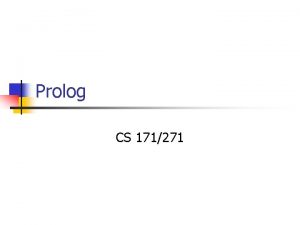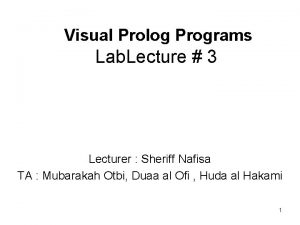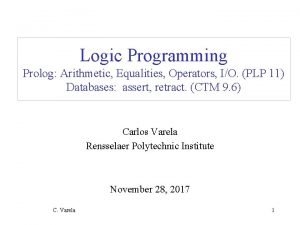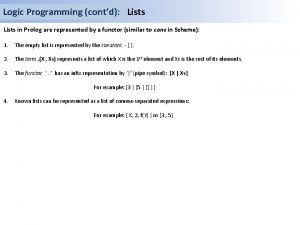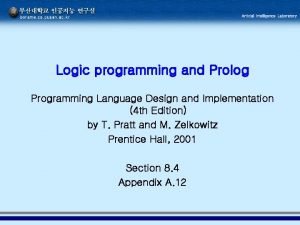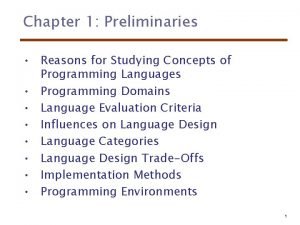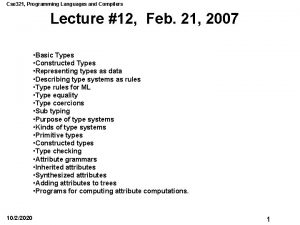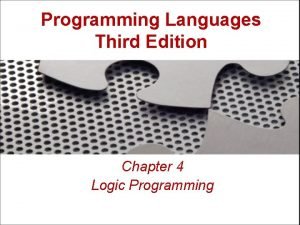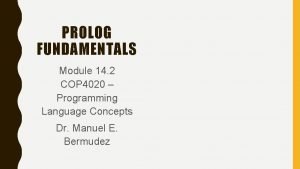COP 4020 Programming Languages Logical programming with Prolog







![List Operations: List Membership n n List membership definitions: member(X, [X|T]). member(X, [H|T]) : List Operations: List Membership n n List membership definitions: member(X, [X|T]). member(X, [H|T]) :](https://slidetodoc.com/presentation_image/165cc64b696f9681ae4ee37ef7dc1ed0/image-8.jpg)

![Predicates and Relations ? - member(b, L). L = [b|_G 545] ; L = Predicates and Relations ? - member(b, L). L = [b|_G 545] ; L =](https://slidetodoc.com/presentation_image/165cc64b696f9681ae4ee37ef7dc1ed0/image-10.jpg)


![Example: List Append n n n n List append predicate definitions: append([], A, A). Example: List Append n n n n List append predicate definitions: append([], A, A).](https://slidetodoc.com/presentation_image/165cc64b696f9681ae4ee37ef7dc1ed0/image-13.jpg)




![Example: sorting n How to write is_sorted? is_sorted([]). is_sorted([_]). is_sorted([X, Y | L]) : Example: sorting n How to write is_sorted? is_sorted([]). is_sorted([_]). is_sorted([X, Y | L]) :](https://slidetodoc.com/presentation_image/165cc64b696f9681ae4ee37ef7dc1ed0/image-18.jpg)
- Slides: 18

COP 4020 Programming Languages Logical programming with Prolog Prof. Xin Yuan

Topics n Logic programming with Prolog 10/28/2020 COP 4020 Spring 2014 2

Definitions: Prolog Terms n n Terms are symbolic expressions that are Prolog’s building blocks A Prolog program consists of Horn clauses (axioms) that consist of terms Data structures processed by a Prolog program are terms A term is either ¨ ¨ ¨ n a variable: a name beginning with an upper case letter a constant: a number or string an atom: a symbol or a name beginning with a lower case letter a structure of the form: functor(arg 1, arg 2, . . . , argn) where functor is an atom and argi are sub-terms a list (also a structure with a functor) of the form [term 1, term 2, …, termn] Examples: X, Y, ABC, and Alice are variables ¨ 7, 3. 14, and ”hello” are constants ¨ foo, bar. Fly, and + are atoms ¨ bin_tree(foo, bin_tree(bar, glarch)) and +(3, 4) are structures ¨ 10/28/2020 COP 4020 Spring 2014 3

Term Manipulation n Terms can be analyzed and constructed ¨ Built-in predicates functor and arg, for example: n n ¨ ? - functor(foo(a, b, c), foo, 3). yes ? - functor(bar(a, b, c), F, N). F = bar N = 3 ? - functor(T, bee, 2). T = bee(_G 1, _G 2) ? - functor(T, bee, 2), arg(1, T, a), arg(2, T, b). T = bee(a, b) The “univ” operator =. . n Break up a term into a list or form a term from a list. ¨ ¨ 10/28/2020 ? - foo(a, b, c) =. . L L = [foo, a, b, c] ? - T =. . [bee, a, b] T = bee(a, b) COP 4020 Spring 2014 4

Unification and Variable Instantiation n n Variables are used in clauses: A variable is instantiated to a term as a result of unification, which takes place when goals are matched to head predicates Goal in query: rainy(C) ¨ Fact: rainy(seattle) ¨ Unification is the result of the goal-fact match: C=seattle ¨ n Unification is recursive: An uninstantiated variable unifies with anything, even with other variables which makes them identical (aliases) ¨ An atom unifies with an identical atom ¨ A constant unifies with an identical constant ¨ A structure unifies with another structure if the functor and number of arguments are the same and the arguments unify recursively ¨ n Once a variable is instantiated to a non-variable term, it cannot be changed: “proofs cannot be tampered with” 10/28/2020 COP 4020 Spring 2014 5

Examples of Unification n The built-in predicate =(A, B) succeeds if and only if A and B can be unified, where the goal =(A, B) may be written as A = B ¨ ¨ ¨ ¨ ? - a = a. yes ? - a = 5. No ? - 5 = 5. 0. No ? - a = X. X = a ? - foo(a, b) = foo(a, b). Yes ? - foo(a, b) = foo(X, b). X = a ? - foo(X, b) = Y. Y = foo(X, b) ? - foo(Z, Z) = foo(a, b). no 10/28/2020 COP 4020 Spring 2014 6

Prolog Lists n A list is of the form: [elt 1, elt 2, . . . , eltn] n where elti are terms The special list form [elt 1, elt 2, . . . , eltn | tail] n denotes a list whose tail list is tail Examples ? - [a, b, c] = [a|T]. T = [b, c] ¨ ? - [a, b, c] = [a, b|T]. T = [c] ¨ ? - [a, b, c] = [a, b, c|T]. T = [] ¨ 10/28/2020 COP 4020 Spring 2014 7
![List Operations List Membership n n List membership definitions memberX XT memberX HT List Operations: List Membership n n List membership definitions: member(X, [X|T]). member(X, [H|T]) :](https://slidetodoc.com/presentation_image/165cc64b696f9681ae4ee37ef7dc1ed0/image-8.jpg)
List Operations: List Membership n n List membership definitions: member(X, [X|T]). member(X, [H|T]) : - member(X, T). ? - member(b, [a, b, c]). ¨ ¨ ¨ ¨ Execution: member(b, [a, b, c]) does not match member(X, [X|T]) member(b, [a, b, c]) matches predicate member(X 1, [H 1|T 1]) with X 1=b, H 1=a, and T 1=[b, c] Sub-goal to prove: member(b, [b, c]) matches predicate member(X 2, [X 2|T 2]) with X 2=b and T 2=[c] The sub-goal is proven, so member(b, [a, b, c]) is proven (deduced) Note: variables can be "local" to a clause (like the formal arguments of a function) Local variables such as X 1 and X 2 are used to indicate a match of a (sub)-goal and a head predicate of a clause 10/28/2020 COP 4020 Spring 2014 8

Predicates and Relations n n Predicates are not functions with distinct inputs and outputs Predicates are more general and define relationships between objects (terms) member(b, [a, b, c]) relates term b to the list that contains b ¨ ? - member(X, [a, b, c]). X = a ; % type '; ' to try to find more solutions X = b ; %. . . try to find more solutions X = c ; %. . . try to find more solutions no ¨ ? - member(b, [a, Y, c]). Y = b ¨ ? - member(b, L). L = [b|_G 255] where L is a list with b as head and _G 255 as tail, where _G 255 is a new variable ¨ 10/28/2020 COP 4020 Spring 2014 9
![Predicates and Relations memberb L L bG 545 L Predicates and Relations ? - member(b, L). L = [b|_G 545] ; L =](https://slidetodoc.com/presentation_image/165cc64b696f9681ae4ee37ef7dc1ed0/image-10.jpg)
Predicates and Relations ? - member(b, L). L = [b|_G 545] ; L = [_G 544, b|_G 548] ; L = [_G 544, _G 547, b|_G 551] ; L = [_G 544, _G 547, _G 550, b|_G 554] ; L = [_G 544, _G 547, _G 550, _G 553, b|_G 557] ; L = [_G 544, _G 547, _G 550, _G 553, _G 556, b|_G 560] ; L = [_G 544, _G 547, _G 550, _G 553, _G 556, _G 559, b|_G 563]. 10/28/2020 COP 4020 Spring 2014 10

Example: List Append n n n L 3 = L 1 || L 2. How to write this in Prolog? Predicates do not have return value ¨ n L 1, L 2, L 3 must be arguments to a predicate, the programming will then specify the relation. ¨ n Implication? Append(L 1, L 2, L 3). Define this recursively Case 1: when L 1 is empty ¨ Case 2: when L 1 is not empty ¨ Prolog has not if constructs, how to do two cases? ¨ 10/28/2020 COP 4020 Spring 2014 11

Example: List Append n Append(L 1, L 2, L 3). %L 3 = L 1 || L 2 n Define this recursively ¨ Case 1: when L 1 is empty n ¨ append([], L 2). Case 2: when L 1 is not empty n n append([H | T], L 2, [H | append(T, L 2) ]) – of course this is incorrect, append does not have a return value. Solution: ¨ n append ([H | T], L 2, [H | L]) : - append(T, L 2, L). Final solution: append([], A, A). append([H|T], A, [H|L]) : - append(T, A, L). 10/28/2020 COP 4020 Spring 2014 12
![Example List Append n n n n List append predicate definitions append A A Example: List Append n n n n List append predicate definitions: append([], A, A).](https://slidetodoc.com/presentation_image/165cc64b696f9681ae4ee37ef7dc1ed0/image-13.jpg)
Example: List Append n n n n List append predicate definitions: append([], A, A). append([H|T], A, [H|L]) : - append(T, A, L). Prolog append is more power then the append function in other languages ? - append([a, b, c], [d, e], X). X = [a, b, c, d, e] ? - append(Y, [d, e], [a, b, c, d, e]). Y = [a, b, c] ? - append([a, b, c], Z, [a, b, c, d, e]). Z = [d, e] ? - append([a, b], [a, b, c]). No ? - append([a, b], [X|Y], [a, b, c]). X = c Y = [] 10/28/2020 COP 4020 Spring 2014 13

Example: take out one element from a list n n predicate prototype: takeout(Item, Src. L, Dst. L) Three cases: Src. L is empty ¨ Src. L is not empty: the first element is Item (take out this item) ¨ Src. L is not empty: the first element is not Item (Keep this item) ¨ 10/28/2020 COP 4020 Spring 2014 14

Example: take out one element from a list n n Example 6. pl Item may or may not be in Src. L ¨ Three cases: n Src. L is empty: ¨ n Src. L is not empty: the first element is Item (take out this item) ¨ n takeout(Item, [Item | L], L). Src. L is not empty: the first element is not Item (Keep this item) ¨ n takeout(Item, []). Takeout(Item, [X | L], [X | L 1]) : - takeout(Item, L, L 1). Item must be in Src. L? 10/28/2020 COP 4020 Spring 2014 15

Permutation of a list n perm(L 1, L 2). %L 2 is a permutation of L 1 n n perm([], []). perm([X|Y], Z) : - perm(Y, W), takeout(X, Z, W). n Example 7. pl 10/28/2020 COP 4020 Spring 2014 16

Example: sorting n Interface: sort(List, Sortedlist). ¨ n All variables must start with a capital letter. Naïve_sort (very inefficient sorting) naive_sort(List, Sorted): -perm(List, Sorted), is_sorted(Sorted). n How to write is_sorted? 10/28/2020 COP 4020 Spring 2014 17
![Example sorting n How to write issorted issorted issorted issortedX Y L Example: sorting n How to write is_sorted? is_sorted([]). is_sorted([_]). is_sorted([X, Y | L]) :](https://slidetodoc.com/presentation_image/165cc64b696f9681ae4ee37ef7dc1ed0/image-18.jpg)
Example: sorting n How to write is_sorted? is_sorted([]). is_sorted([_]). is_sorted([X, Y | L]) : - X < Y, is_sorted([Y|L]). 10/28/2020 COP 4020 Spring 2014 18
 Good cop bad cop interrogation
Good cop bad cop interrogation Cop 1 cop 2
Cop 1 cop 2 Visual prolog vs swi-prolog
Visual prolog vs swi-prolog Domain in prolog
Domain in prolog Prolog symbols
Prolog symbols As nzs 4020
As nzs 4020 Center for army analysis
Center for army analysis Gaji paskau
Gaji paskau Logical equivalence
Logical equivalence Kesetaraan logis adalah
Kesetaraan logis adalah Prolog programming
Prolog programming Prolog language
Prolog language Xenia programming languages
Xenia programming languages Joey paquet
Joey paquet Reasons for studying concepts of programming languages
Reasons for studying concepts of programming languages Programming languages
Programming languages Programing languages
Programing languages Transmission programming languages
Transmission programming languages Cxc it
Cxc it


